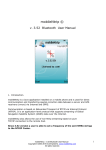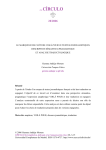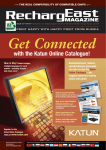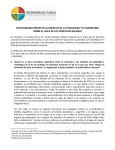Download 101 Uncomfortable Truths
Transcript
The Content Marketing Fallacy By Dr D Price #thinkdifferent – get results April 2014 TO O BAD IF YO U W ANTTO BE A C ONTENT MARKETER So here I am tackling another fight I won’t win. There are way too many ‘gurus’ with vested interests espousing the rise and rise of content marketing for one person to turn thetide. So as before, this fad will have to go through the natural cycle to eventual obsolescence. (The only question is how much time/resources will be wasted on this before it happens.) Content Marketing is a wannabe discipline and people’s fascination with it is entirely built on a logical fallacy. I am sure every reader can cast their mind back to a recent sports broadcast where a commentator would say something to similar to this: The team is going so well but they are struggling to scorebecause the last pass is always going to ground. Or if you aren’t a sports fan, I am sure you have heard the expression. The keys are always in the last place I looked. T he question is: is there any other place the keys could have been – BUT thelast place? Was there any other pass that could have been dropped but the last one? And it is the same thing with the notion of content marketing. Is internet marketing even possible without ‘content? At every opportunity wannabe gurus jump on anything that looks like it can become a bandwagon and claim to be a ‘leader’ with whatever the next big thing is, and they flog it to corporates who suffer a terminal case of FOMO. 1 T he image below came up in a Google search, and whether it was or wasn’t is not the point here, but it would have been something LIKE this. Look at again and you will notice that it nothing but (links to) CONT ENT . Read the definition of the World Wide Web again: a wide-area hypermedia information retrieval initiative aiming to give universal access to a large universe documents. T he only thing that has changed is thedifferent ‘document’ formats have emerged enabling multi-media in addition to documents. FACT #1:T HE INT ERNET ISCONT ENT. T his implies that coming up with a term like Content Marketing would be exactly the same as saying traditional marketing is (for example) Communication Marketing – and THEN claiming that ‘communication marketing’ is different and has special taxonomies and special skills and you need to a special kind of guru to be a communication marketer. Ihope it is obvious that all marketing is communication and adding an unwarranted adjunct adds no meaningful value. Here is a great infographic on my Pinterest account that explainswhat happens in ONE internetminute. In 2015, it will take us 5 YEARS to watch the amount of video that is uploaded in ONE minute onto the internet. Study the infographic andtell me how easy it is to create contentthat will actually be found? 2 I am sure it boggles your mind as it does mine. There is really only one conclusion thatone can draw. FACT #2:T HERE ISA LOT OFCONT ENT – AND MORE ISCOMING. T his means that even if there was such a thing as content marketing then it is going to become increasingly difficult – to the point of irrelevance. Of course there are better and worse ways to organise and present your information on the internet and if that is all that content marketing is, then I will leave it at that. But Content Marketing is really a statement of the bleeding obvious when it comes to theinternet and unless a ‘content marketer’ can develop a model that will a-priori determine what content will be viral, I can’t see it adding much value to our understanding of how and why people buy and what we can do to use that in a marketing context that we cannot already do. More neologisms is the last thing weneed. Since a new label of and by itself adds no real value, I prefer to use the time-proven frameworks to leverage new insights. 3 FACT #3: EVEN IFYOU PUT DOWN T HE KOOL-AID FOR A MOMENT, YOU ST ILL MUST FIGURE OUT WHAT ISNEXT . All content is information and all information that exists to drive sales is a form of ‘advertising’. And advertising has traditionally been organised around the following three goals: Inform, Persuade, and Remind. So, when I look to understand the future of marketing and advertising (getting people to buy stuff) I look at how other social and technological changes will drive change within existing frameworks without adding pop-culture bling to our marketing literature because we suffer from Neophilia. So considering the three traditional core objectives of Advertising, one might speculate how these may change orhow they may be impacted by change. REMIND It seems that advertising won’t need to play that role much in the future. T heinternet of things will obviate the need for reminders via third party communications channels – the reminders will be built into the product, into monitors and/or wearable computers. PERSUADE Already the dominant paradigm is one that avoids overt persuasion. Consumers are becoming increasingly aware and informed of traditional marketing tactics. Even Neuromarketing and all the associated heuristics are relative accessible by the everyday consumer viapopular blogs and even mainstream media programs. (After watching a T V show like ‘Lieto Me’, everyone is a body language expert.) Persuasion is (and should be) now practiced in a more ‘organic’ format – where the marketer is respectful of consumer’s ‘rights’ and most marketers live by the prevailing desire to be ‘authentic’. T his ofcourse makes outright persuasion effectively illegitimate. INFORM Information that simply informs is not ofany particular use. One should consider the subsets of information that consumers may want and that is (a) entertainment and (b) education. As a marketer it seems to me that if we want our content to be found and to be have an impact, it must be either entertaining or educational. Marketing as a professional discipline struggles because its practitioners are constantly jumping on the next band wagon, proclaiming “ this is thebig thing”. Social media – and a specific range of platforms come to mind and of course then there is the other buzz word – Big Data. (I read somewhere that Big Data is like Teenage Sex – everyone thinks everyone else is doing it and therefore claim they are doing it, but the reality is there is much groping in the dark and not much else.) By labelling what we do as “ Customer Education”and claiming that it is thenew marketing, I run the risk that the same fate will befall it; a slow, agonising death until all that remains are a few abandoned websites in the Google graveyard. 4 T he current crop of young marketers who are ‘discovering’ social mistakenly believe that they have discovered something amazingly unique about consumers. People are social. It doesn’t take more than a moment’s reflection to realise that humans have ALWAYS been social. T he only thing that has changed is that (1) it is easier for people to use technology to express their social nature and (b) the social dimension of decision-making has shifted power to the consumer because brands are no longer custodians of the information needed to make decisions. By the same token, marketing has always been about customer education. When a manufacturer includes a user manual in their packaging, they are attempting to educate the customer. T he reason I believe content marketing is a dead end (in addition to those already enumerated) is that content marketing (as it is practised today) is biased towards entertainment – as can be seen from the unrealistic and counterproductive focus on creating something viral. Content can be entertaining and it can be educational. It can even beboth at the same time. But pure entertainment is not – in our experience - a viable, effective and sustainable marketing strategy unless your product/service is an entertainment product (like XBOX). By definition someone who wants to be ‘entertained’ always wants to move on to the next thing… which goes against the grain of the organisational objective of creating loyal and repeat customers. At best, content marketing is part of yourdigital marketing strategy which is part of your overall marketing strategy. Customer education is a nobler endeavour. Personally, (and this is a function of being in the B2B space) I would tend to avoid content that exists for the sake of entertainment in order to achieve commercial objectives. Watching the latest Old Spice advertisement is entertaining and for many reasons that are only clear ex post facto, and there is a concomitant commercial impact. (Other examples would be in-flight safety demonstration videos being used to promote an airlines brand in adifferent environment in a different way.) Entertainment as marketing is a legitimate strategy. I believe it is less relevant in the B2B space and it is in any event it is much harder to create entertainment that has commercial outcomes. By definition entertainment is difficult and subjective and people seeking entertainment are fickle, and marketers who take the long shot that their entertaining content will change consumer behaviour must think carefully. O UR C O REMARKETING O BJEC TIVEIS C USTO MER EDUCATIO N. Ganador focuses on client/customer/member acquisition, retention and engagement for the B2B market in the retail supply chain. In practice what this means is that we develop strategies/ products (solutions) that will help our clients acquire/retain customers by educating them. 5 A few examples to illustrate from our business: When we work with a shopping centre manager to retain a tenant that has fallen on hard times, we engage, advise, support the tenant BUT do it in such way that we are actually educating the retailer and the shopping centre manager. When we work with an association to increase their membership base, we don’t typically suggest ads in the trade press. T hat is a valid strategy, but it is not what we do. Instead we will focus on how we can leverage the IP that exists in the Association to make membership more attractive and beneficial – and educate their (prospective) members. In essence, we think the ‘marketing’ that will survive will be marketing that is USEFUL. If you can reformat your marketing message to be useful by making it educational, it will have a sustainable basis for building relationships. MARKET ING IS LIKE EDUCAT ION: 1. 2. 3. 4. 5. 6. 7. 8. 9. 10. 11. 12. 13. 14. 15. At its heart it is a form of gentle leading. It’s people-centric: about the recipient, not the ‘sender’. You remember the great experiences. It is sustained. (It is a life-long journey) It is sustainable. It is sustaining. T echnology is an enabler, not a substitute. It is rewarding (everybody benefits). It is authentic. It is a form of conversation. T he fundamentals never change (andit will survive the buzzwords). T he best system creates a virtuous circle of beneficiaries. T he benefitslast forever. You can share, expose, challenge, inform, teach – but you cannot MAKE anyone loveit. You can’t fake it (the ‘kids’ will catch you out in a blink) The revealing power of knowledge and truth will reveal the heart of the brand. If you genuinely believe your brand is the right solution then you will seek and embrace this exposure. Instead of ‘influencing’ the customer to buy, they become driven to buy because they know the product/brand is the best fit for them. T hat is the most powerful outcome for any brand AND themost ideal result for the consumer. Marketing as education requires a mind-set change as well as a new set of tools and strategies. Some activities may appear superficially thesame as those previously executed – but just like a philosophy lecture and class-room show and tell may ‘look the same’ and appear in the same setting and involve one-to-many communication exercise, they are in effect very different. A marketing activity may LOOK like a training workshop, but it is not. 6 It may look like a consulting gig, but it may be an engagement exercise. It really just depends on intent – and the philosophy behind the execution; but good marketing is education is marketing. If we are right, then this trend has practical implication for all businesses. When commercial organisations use education as a competitive differentiatorit will seriously and materially impact organisational institutions. T he way commercial organisations interact with their customers/clients will change – and in particular the sales process will change in format, frequency and content as the objective changes. (We have created a Checklist for Retail Re presentatives to stimulate your thoughts on this topic and you can get this from the same area on the website – ganador.com.au.) T he implications for retailers specifically (using the example of a fashion retailer) are also significant. Instead of Facebook posts that shout‘new in store, buy now’ – focus on givingthem what’s hot in fashion right now; that is - an education in style & trends. Instead of simply selling your dress, teach them which make-up colours go best with that outfit Since people buy fashion to FIT IN with their peer group, give them some tips and tools to achieve that – without overtly referring to your product Create a community around your blog where your fans can educate each other (sharing tips and shortcuts) isa form of crowdsourcingyour education efforts – which is pretty smart. It also has implications if you are a competitor of ours. Weare happy to give even our competitors some pointers in the right direction because the reality is that eventually they will see the light anyway, and being first is not the greatest competitive advantage for us. When you are at the forefront of innovation and practising cutting edge techniques, you have to not only sell your particular ‘value’, you must persuade theclient that the new approach or the new technology (or whatever is at the cutting edge) is the right one. T he more practitioners out there delivering the same message makes it easier for us to sell our particular offer, so we welcome all competitors into the fold. 7 We like to think we are on the cutting edge of marketing of course. But in the final analysis, what we are promoting here is nothing but the most foundational truth of all marketing – giving the customer what they want. And what they want (now as ever) is to be helped to live their lives better. CONTACT US If you are a wholesaler, brand, distributor, franchisor, publisher, landlord or service provider seeking to engage your clients/customers & members with sustainable business relationships and … WANT T O DO IT SMART ER … we will be happy to talk. Dr Dennis Price [email protected] [m] 0411 030 436 @dennisprice Moonyeen Price [email protected] [m] 0408 200 590 @pricefx GANADOR.COM.AU 8





















